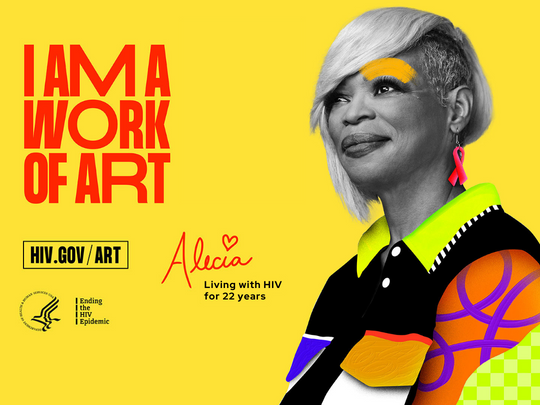“Look at Me, Living and Thriving After Diagnosis”
Topics

For the founder and CEO of the Positive People NetworkExit Disclaimer, each day is precious—living life inspiring others, living life as a work of ART.
“I had heard of HIV, but, back then, all we heard was that people were dying,” says Alecia Tramel, as she described that moment back in 2000 when she was first diagnosed with HIV.
“The first thing that popped into my mind was that I’m leaving my children. I have to make provisions for them to be in a safe space.”
But, because of the advancements in care and treatment, Alecia did not leave. In fact, she did quite the opposite. Like the majority of people with HIV in the United States, she is alive and well—living the “best years of my life,” as she describes it.
Twenty-two years later, Alecia has not only created that “safe space” for her children, but she has inspired hope in other people with HIV through her work with the organization that she founded, Positive People Network, and her partnership with initiatives such as the “I am a Work of ART” campaign.
Alecia is one of the 14 creative partners who share their stories as part of “I am a Work of ART,” the national viral suppression campaign recently launched by the HHS Office of Infectious Disease and HIV/AIDS Policy (OIDP) as part of the Ending the HIV Epidemic in the U.S. (EHE) initiative. The vibrant, life-affirming campaign encourages people with HIV who are not in care, or in and out of care, to seek care, get into care, and achieve viral suppression by taking antiretroviral therapy, also known as “ART.” Playing off of the dual meaning of “art,” the campaign encourages people to find an HIV care provider that is right for them by visiting HIV.gov/ART so they can protect their health, prevent transmission, and live their lives as a “work of ART.”
In recalling her journey from initial HIV diagnosis to living life as a work of ART, Alecia talked about the practical guidance provided to her by people who had been on their journeys before her. Alecia recalls them saying “Don’t worry about it, girl, you’ll be alright. Just take your medication and go to the doctor. That’s all we’ve been doing and it’s working for us so far.”
“That was the best advice I had ever gotten,” Alecia says.
That advice has been working for many others as well. Of the 1.2 million people with HIV in the U.S., 66% are receiving some form of care and more than 57% are virally suppressed. In order to achieve our national goal of ending the HIV epidemic, however, OIDP and the U.S. Federal Government is committed to increasing this number of people who are virally suppressed by engaging more people with HIV in areas where the viral suppression rates are lower than the national rate, encouraging them to seek and stay in care so they too can achieve viral suppression. People who keep an undetectable viral load can live long and healthy lives and will not transmit HIV to their HIV-negative partners through sex, often referred to as “undetectable = untransmittable” or “U=U”.
Alecia is one of the many people with HIV who report “good” or “good or better health,” in part because of their HIV care. That’s one important dimension of quality of life among people with HIV that the National HIV/AIDS Strategy (NHAS) seeks to improve. One of the new NHAS indicators of progress sets a target of increasing the proportion of people with diagnosed HIV who report “good or better health” to 95% by 2025. Engaging more people with HIV in care and treatment so they can achieve and maintain viral suppression is an important means to realizing this goal.
“I do have more frequent doctor appointments now because I want to stay healthy and stay alive,” Alecia says. “I’m healthy as an ox, healthier than most people I know because I’m always on top of my health. It’s been a blessing for me and a blessing to others.”
“Look at me, living and thriving after diagnosis,” Alecia says. “I’m being the solution.”
The “I am a Work of ART” campaign is supported by the Minority HIV/AIDS Fund and can be used by all communities to encourage the use of ART to achieve viral suppression. Campaign materials feature 14 creative partners and include video and audio public service announcements, posters, flyers, social media graphics, as well as rack and business cards. Many of the materials are also available in both English and Spanish.
If you are looking for a provider in your area to start or re-start ART or if you are looking for more information about the campaign or to download materials, please visit HIV.gov/ART.